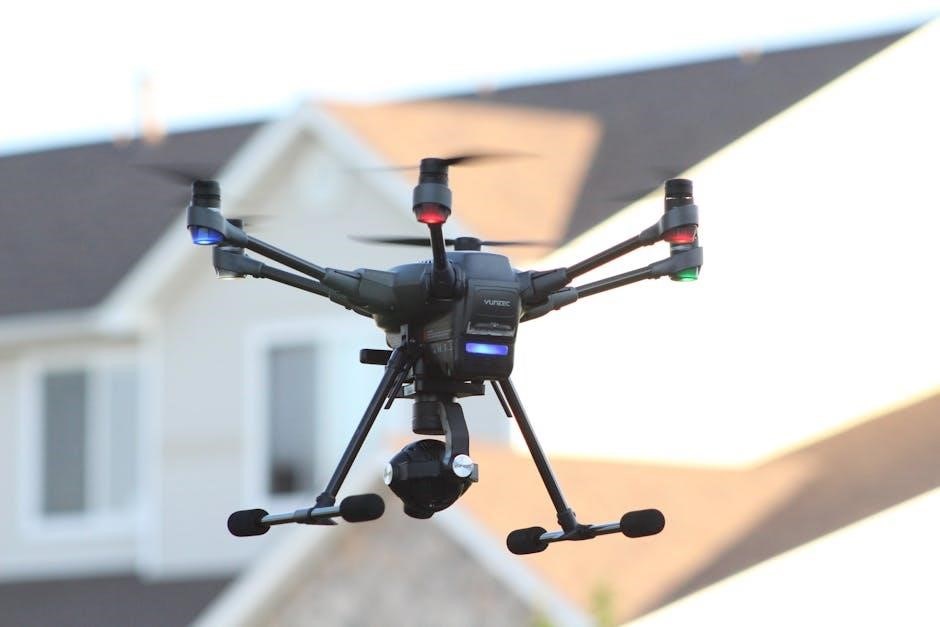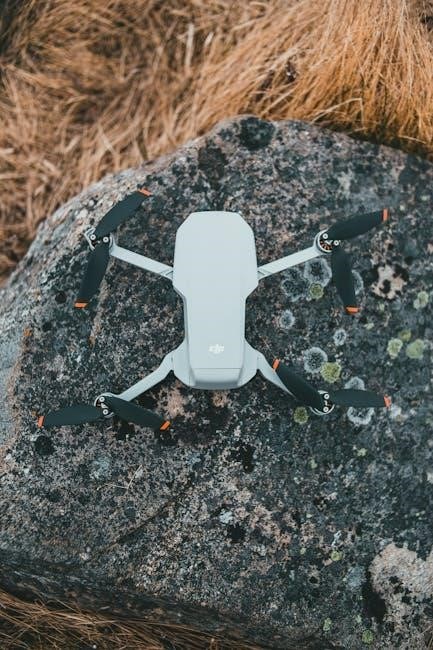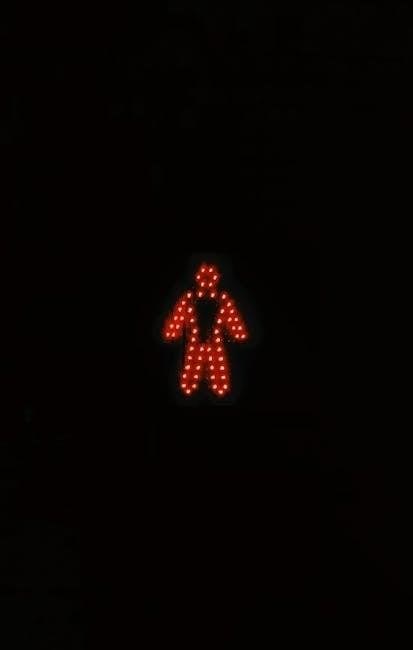
An LED light strip remote control offers a convenient method to manage lighting․ It allows users to adjust brightness, change colors, and set modes, enhancing ambiance with ease․
1․1 Overview of LED Light Strip Remote Control
An LED light strip remote control is a versatile tool designed to enhance lighting convenience․ It typically includes functions like On/Off, brightness adjustment, and color temperature control․ Many remotes also offer flashing modes, speed control, and pause options, allowing users to customize their lighting experience․ Compatibility varies, so ensuring the remote matches the LED strip’s voltage is crucial․ The remote simplifies operation, making it easy to create the perfect ambiance without physical adjustments․ Its user-friendly design ensures seamless control, catering to both basic and advanced lighting needs․
1․2 Benefits of Using Remote Control for LED Light Strips
Using a remote control for LED light strips offers exceptional convenience and flexibility․ It allows users to adjust brightness, change colors, and toggle modes effortlessly from a distance․ This eliminates the need for physical adjustments, making it ideal for hard-to-reach installations․ The remote also enables customizable lighting effects, such as flashing or dimming, to create unique ambiance․ Additionally, it simplifies operation for multiple strips, ensuring a seamless and energy-efficient lighting experience․ Overall, a remote control enhances both functionality and user satisfaction, making it an essential accessory for modern LED lighting systems․

Understanding the Components
LED light strip systems include the strip itself, a remote control, a controller, and a power supply․ These components work together to enable seamless lighting control and customization․
2․1 LED Light Strip Components
The LED light strip consists of a flexible strip with embedded LEDs, an adhesive backing, and a connector․ It requires a controller to regulate functions like brightness and color․ The power supply provides the necessary voltage, typically 12V or 24V, to operate the strip․ These components are designed to work seamlessly together, ensuring reliable performance and ease of use․ Proper connection of these elements is essential for optimal functionality and safety․
2․2 Remote Control Features and Buttons
The remote control typically includes buttons for on/off, brightness adjustment, and color temperature selection․ Special features like flashing modes and speed control are also common․ The pause button allows users to halt the current mode, while colored buttons enable static color selection․ Some remotes feature arrow buttons for adjusting effect intensity or speed․ These buttons provide precise control over the LED strip’s appearance and behavior, making it easy to customize the lighting experience․ Proper use of these features enhances the overall functionality and user experience․
Installation and Setup
Installation involves cleaning the surface, peeling the adhesive, and sticking the strip․ Connect the LED strip to the controller and plug in the power supply․ Ensure the controller is properly powered․
3․1 Preparing the Surface for Installation
Ensure the surface is clean, dry, and free from dust or grease for optimal adhesion․ Wipe the area with a mild cleaner and let it dry completely․ Remove any old adhesive residue․ Check for smoothness and compatibility—LED strips work best on flat, stable surfaces․ Avoid installing near direct sunlight or moisture․ Peel the backing strip slowly to prevent stretching or bending․ For uneven surfaces, use additional clips or brackets for secure placement․ Proper preparation ensures a seamless and efficient installation process․
3․2 Connecting the LED Light Strip to the Controller
Align the LED strip’s connector with the controller’s input port․ Gently push until it clicks․ Ensure the arrows on the strip match the controller’s direction․ Secure it firmly to prevent loose connections․ For longer strips, use splitters or extension cables if necessary․ Avoid bending the connector at sharp angles․ After connecting, test the strip by pressing the remote’s on/off button․ If it doesn’t respond, check the connection and ensure the remote is paired․ Proper connection ensures reliable control and optimal performance․
3․3 Power Supply Connection
Connect the power supply to the controller by inserting the DC plug into the designated port․ Ensure the supply matches the strip’s voltage (12V or 24V)․ Plug the adapter into a wall outlet․ Avoid using damaged cords or incorrect adapters․ After powering on, test the strip with the remote․ If it doesn’t activate, check connections and voltage compatibility․ Secure the setup to prevent accidental disconnections․ Always follow safety guidelines to avoid electrical hazards․ Proper power connection is crucial for safe and efficient operation․ Ensure all components are approved for your region’s standards․
Pairing the Remote Control with LED Light Strips
Pairing ensures the remote communicates with the LED strip․ Some strips are factory-paired, while others require manual syncing․ Follow the remote’s instructions for a seamless connection․
4․1 Factory-Paired vs․ Manual Sync
LED light strips can be factory-paired with their remotes, ensuring immediate operation․ However, if the remote is replaced or additional strips are added, manual syncing is required․ Factory-paired strips eliminate the need for manual setup, while manual syncing offers flexibility for custom configurations․ Some remotes are pre-programmed to work with specific strips, but compatibility must be verified․ Manual syncing typically involves pressing a combination of buttons on the remote or controller․ Always refer to the user manual for precise instructions, as procedures may vary between models and brands․
4․2 Steps to Pair the Remote Control
To pair the remote control with your LED light strip, start by turning on the power supply․ Press and hold the pairing button on the controller for 3-5 seconds until it enters pairing mode․ Next, use the remote to activate the pairing function, typically by pressing a specific button combination․ Ensure the remote and strip are compatible․ If pairing is successful, the light will respond to remote commands․ Refer to the user manual for exact steps, as procedures may vary․ Proper pairing ensures smooth and reliable control of your LED light strip․

Operating the Remote Control
Use the remote to turn LED strips on/off, adjust brightness, and change color modes․ Special features like flashing and pause enhance control for a personalized experience․
5․1 Basic Functions: On/Off and Brightness Control
The remote control features a dedicated On/Off button for powering the LED strip․ Adjust brightness using the plus (+) and minus (-) buttons, allowing seamless light intensity customization․ Pressing the Pause key temporarily halts the current mode, giving you full control over your lighting experience․ These functions ensure easy and intuitive operation, enabling you to tailor the lighting to your preferences effortlessly․ The straightforward design makes it simple to manage your LED strip’s basic operations with minimal effort․
5․2 Adjusting Color Temperature and Modes
Use the remote to adjust the color temperature of your LED strip, selecting from warm to cool tones․ Press the color temperature selector to cycle through options․ The remote also allows you to switch between static modes and dynamic modes, such as flashing or fading․ Certain remotes feature colored buttons for direct color selection․ Adjust the speed or intensity of effects using arrow buttons․ This functionality lets you customize the lighting to match your mood or environment seamlessly․ Explore various modes to enhance your space with vibrant and dynamic lighting effects․
Enhance your LED light experience with special features․ Use the flashing mode button to create dynamic effects․ Adjust the speed of flashing or fading using designated buttons․ The pause function allows you to stop the current mode temporarily․ Experiment with these features to create unique lighting effects for parties or relaxation․ Explore sunrise and sunset modes for gradual light transitions․ These features add versatility to your lighting setup, making it adaptable to various occasions and preferences․
Discover advanced features for tailored lighting experiences․ Customize settings like timers, schedules, and multi-strip syncing․ Explore additional accessories to enhance functionality and personalization for optimal lighting control․ Syncing multiple LED strips with one remote allows seamless control of your lighting system․ Some strips come pre-paired, while others require manual syncing․ Ensure compatibility by checking the remote’s capacity․ To sync, power on all strips, then press and hold the remote’s sync button until the lights flash․ This links the strips to the remote, enabling uniform control․ For added convenience, group strips by zones or rooms for tailored lighting effects․ This feature enhances customization and simplifies operation, making it ideal for large or multi-zone lighting setups․ Setting up timer and schedule functions on your LED light strip remote enhances convenience․ Use the remote’s built-in timer to automate on/off times․ Press the clock button, then use arrow keys to set hours and minutes․ Save settings with the confirm button; For schedules, some remotes allow programming multiple on/off cycles․ This feature is perfect for simulating occupancy or managing energy use․ Advanced models may offer app integration for more complex scheduling․ Always refer to the user manual for specific instructions, ensuring optimal use of these smart features․ Always read the user manual before use․ Ensure voltage compatibility between the LED strip and power supply․ Avoid overloading circuits and keep flammable materials away from lights․ Reading the user manual is essential for safe and proper use of LED light strips and their remote controls․ The manual provides detailed instructions on installation, operation, and troubleshooting․ It outlines compatibility, voltage requirements, and safety precautions to avoid electrical hazards․ Understanding the manual ensures optimal performance and prevents damage to the system․ Always review the guide before connecting any components to guarantee a secure setup and to familiarize yourself with remote functions and features․ Ensuring voltage compatibility is crucial for the safe operation of LED light strips and their remote controls․ Always verify that the LED strip matches the controller’s input voltage, typically 12V or 24V․ Using mismatched components can cause damage or electrical hazards․ Avoid overloading circuits and keep components away from water to prevent shocks․ Adhere to electrical safety guidelines to protect both the system and users from potential risks․ Proper voltage alignment ensures reliable performance and longevity of the lighting setup․ Common issues with LED strips include connectivity problems and remote malfunctions․ Checking connections and resetting devices often resolves these problems efficiently, restoring functionality quickly and effectively․ If the remote control stops responding, ensure batteries are installed correctly and not depleted․ Verify that the remote is paired with the LED strip and within range․ Check for obstructions blocking the infrared signal․ Restart the LED strip and remote, and ensure both are powered on․ If issues persist, refer to the user manual for reset instructions or contact customer support for further assistance to resolve the connectivity problem effectively․ If the LED strip doesn’t turn on, first check the power supply connection․ Ensure the strip is properly connected to the controller and that the power adapter is plugged in․ Verify that the remote control is functioning and paired correctly with the strip․ Check for any visible damage to the strip or connections․ If issues persist, consult the user manual or contact support for troubleshooting steps to diagnose and resolve the problem effectively and safely․ Resetting your LED light strip and remote restores factory settings, resolving connectivity issues․ This process varies by model but often involves pressing specific buttons or power cycling․ Resetting the LED light strip involves turning it off, disconnecting the power supply, and waiting 10 seconds before reconnecting․ This clears stored settings and restores factory defaults․ For some models, pressing and holding specific buttons on the remote while powering on can also reset the strip․ Always ensure compatibility with your remote control․ If issues persist, refer to the user manual for detailed reset instructions tailored to your specific LED light strip model․ To reset the remote control, remove the batteries and wait 10 seconds․ Reinstall them and test the remote․ If issues persist, press and hold the power button while turning it on to restore default settings․ Ensure compatibility with your LED light strip for proper functionality․ Consult the user manual for specific reset instructions if necessary․ LED light strip remote controls offer easy, versatile lighting management․ They enhance convenience, energy efficiency, and ambiance․ Explore additional features for a tailored lighting experience․ For the best experience with your LED light strip remote control, ensure the surface is clean before installation․ Regularly clean the strips to maintain brightness․ Use the remote’s features wisely, exploring color modes and timers; Store the remote in a safe place to avoid battery drain․ Check compatibility before adding more strips․ Refer to the manual for troubleshooting, and update firmware if available․ Experiment with different settings to find your perfect ambiance․ Proper care ensures longevity and optimal performance of your lighting system․ Enhance your LED light strip experience by exploring extra features and accessories․ Consider adding timers for automated lighting schedules․ Motion sensors can provide hands-free control․ Wi-Fi or Bluetooth adapters enable smartphone app control․Dimmers and color wheels expand customization options․ Accessories like extension strips or connectors allow for larger installations․ Experimenting with these additions can create a personalized and dynamic lighting setup, taking your space to the next level of comfort and style․ Always ensure compatibility with your existing system for seamless integration․5․3 Using Special Features: Flashing, Speed Control, and Pause
Advanced Features and Customization
6․1 Syncing Multiple LED Strips with One Remote
6․2 Setting Up Timer and Schedule Functions

Safety Precautions and Best Practices
7․1 Reading the User Manual
7․2 Voltage Compatibility and Electrical Safety
Troubleshooting Common Issues
8․1 Remote Control Not Responding
8․2 LED Strip Not Turning On

Resetting the LED Light Strip and Remote
9․1 How to Reset the LED Light Strip
9․2 Resetting the Remote Control
10․1 Final Tips for Optimal Use
10․2 Exploring Additional Features and Accessories